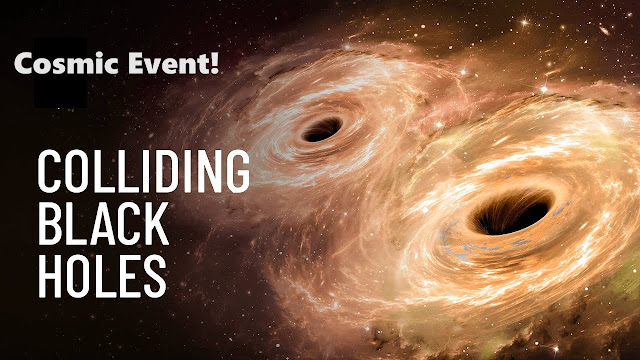What If Two Black Holes Collided? A Mind-Blowing Cosmic Event!
Imagine two of the universe's most powerful entities—black holes—hurtling toward each other and merging in a cataclysmic event. Such collisions, known as black hole mergers, are among the most energetic phenomena in the cosmos, releasing mind-bending amounts of energy and reshaping the surrounding spacetime.
The Process: A Dance of Destruction
When two black holes are on a collision course, they follow a well-defined sequence:
1. Inspiral
- The black holes orbit each other in a gravitational dance.
- As they orbit, they emit gravitational waves—ripples in spacetime—losing energy and spiraling closer together.
- This phase can last for millions to billions of years, depending on their initial distance.
2. Merger
- The black holes approach at incredible speeds, up to half the speed of light.
- They collide, forming a single, larger black hole.
- The merger emits a final burst of gravitational waves, carrying away a portion of their combined mass as pure energy.
3. Ringdown
- The new black hole stabilizes, settling into a stationary state.
- Any distortions or "ripples" in the newly formed black hole are smoothed out by emitting more gravitational waves.
The Energy Release
Black hole collisions release energy in the form of gravitational waves, which are detectable across billions of light-years. For perspective:
- The energy released can be equivalent to converting several solar masses into pure energy in mere seconds.
- The peak power output during a merger can exceed that of all the stars in the observable universe combined!
What Happens to the Surroundings?
Nearby Stars and Planets
- The intense gravitational waves can disrupt nearby objects, though the effects diminish with distance.
- In the immediate vicinity, tidal forces might tear apart stars or scatter planetary systems.
Accretion Disks
- If the black holes have accretion disks (material orbiting them), the collision can produce relativistic jets, beams of energy traveling close to the speed of light.
Detection of Black Hole Collisions
The first detection of a black hole merger came in 2015, when the LIGO observatory identified gravitational waves from a collision between two black holes about 1.3 billion light-years away.
Modern Observatories
- LIGO (Laser Interferometer Gravitational-Wave Observatory) and Virgo detect gravitational waves.
- Observations help astronomers measure black hole masses, spins, and distances.
Significance of Gravitational Waves
- These waves confirm Einstein’s General Theory of Relativity, which predicted their existence a century ago.
- They provide insights into the population of black holes in the universe.
What Happens to the Merged Black Hole?
The resulting black hole is larger than either of the originals but not equal to their combined mass due to energy lost as gravitational waves. Its spin depends on the spin orientations and masses of the original black holes.
- The new black hole might receive a "kick" due to asymmetric gravitational wave emission, causing it to move through space at high speeds.
- In some cases, it could be ejected from its galaxy altogether!
Cosmic Implications
1. Formation of Supermassive Black Holes
Repeated mergers over billions of years could explain the existence of supermassive black holes at the centers of galaxies.
2. Galaxy Evolution
Black hole mergers might influence the formation and growth of galaxies, as gravitational waves and energy output can affect surrounding gas and star formation.
3. Multimessenger Astronomy
When black holes merge with other types of objects, such as neutron stars, the event can also emit electromagnetic radiation, neutrinos, and gravitational waves, offering a wealth of observational data.
Mind-Blowing Facts About Black Hole Collisions
- Speed of Approach: Black holes can orbit each other at speeds close to 50% the speed of light before merging.
- Collision Scale: The merging event can last just a fraction of a second but impact spacetime across billions of light-years.
- Universe-Wide Detection: Observatories on Earth can detect gravitational waves from these events even if they occur billions of light-years away.
What If You Were Nearby?
While the idea of witnessing a black hole merger is fascinating, being close to one would be catastrophic:
- The gravitational waves could distort spacetime enough to affect nearby stars and planets.
- Radiation and energy from the event would make the surrounding environment inhospitable.
Luckily, black hole collisions occur at safe distances from Earth, providing an extraordinary spectacle without posing a direct threat.
Conclusion
The collision of two black holes is a testament to the universe's raw power, showcasing the extremes of physics and energy. These events not only confirm fundamental theories but also offer a glimpse into the dynamic and evolving cosmos. Each merger detected brings us closer to unraveling the mysteries of black holes and their profound role in shaping the universe.
Hashtags
#BlackHoleCollision #GravitationalWaves #CosmicEvents #LIGO #EinsteinRelativity #BlackHoleMerger #SupermassiveBlackHole #Astrophysics
Keywords
Black hole collision, black hole merger, gravitational waves, black hole inspiral, LIGO, TON 618, relativistic jets, cosmic events, Einstein’s theory, supermassive black holes.

No comments:
Post a Comment